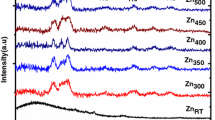Abstract:
ZnSe films were deposited by pulsed laser ablation on a crystalline GaAs substrate and on an amorphous quartz substrate. The deposition process was performed with the same growth parameters. The films were investigated by means of X-ray diffraction, reflectance and photoluminescence spectroscopy. The X-ray diffraction spectra have demonstrated that the films grow in a highly oriented way but having different orientations, i.e. the films deposited on GaAs grow (100)-oriented and the films deposited on quartz grow (111)-oriented. Reflectance spectra as a function of the temperature have been analysed by means of the classical oscillator model, in order to obtain the temperature dependence of the band gap energy. This gives results comparable to those of ZnSe single crystals for ZnSe on GaAs, but it is red-shifted for ZnSe on quartz, because of lattice and thermal strains. The photoluminescence measurements at T = 10 K confirm the better quality of ZnSe deposited on GaAs and show that pulsed laser ablation is a promising technique to grow films having intrinsic luminescence even on an amorphous substrate.
Similar content being viewed by others
Author information
Authors and Affiliations
Additional information
Received 29 May 2002 Published online 31 October 2002
RID="a"
ID="a"e-mail: giuseppe.perna@ba.infn.it
Rights and permissions
About this article
Cite this article
Perna, G., Capozzi, V., Plantamura, M. et al. ZnSe films deposited on crystalline GaAs and amorphous quartz substrates by means of pulsed laser ablation technique. Eur. Phys. J. B 29, 541–545 (2002). https://doi.org/10.1140/epjb/e2002-00337-0
Issue Date:
DOI: https://doi.org/10.1140/epjb/e2002-00337-0




